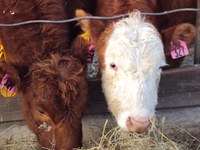Feedout Demonstrates Calves’ Performance
(Click the image below to view a high-resolution image that can be downloaded)
The North Dakota State University Extension Service is seeking cattle producers to participate in the 2010-11 Eastern North Dakota Cattle Feedout.
Producers will be able to consign calves to the program, and the calves will be fed until they're ready for harvest.
The program helps producers understand the value of their herd's genetics in a feedlot situation, according to Karl Hoppe, area Extension livestock specialist at the NDSU Carrington Research Extension Center, which conducts the feedout.
Center staff will give the producers periodic reports on their calves' feedlot performance, as well as carcass data after the calves are harvested.
The program is open to producers from eastern North Dakota and the surrounding region. The deadline to enroll is Dec. 3. Producers should deliver their calves to the Pipestem Feeders feedlot on Dec. 7. The calves will be fed at Pipestem Feeders, a commercial feedlot near the Carrington Research Extension Center.
Producers can consign one or more groups of six spring-born steer calves to the feedout program. Calves should be vaccinated for BVD type I and II, IBR, P13 and BRSV, and with a seven-way clostridial two weeks before being delivered. The calves will be revaccinated, dewormed, deliced, weighed and ear tagged after they’re delivered to the feedlot.
Two to three weeks after the calves arrive at the feedlot, they will be placed on a high-grain diet. The target for harvesting the cattle is 0.5-inch backfat and choice marbling.
Producers retain ownership of the calves during the feeding period, and they're responsible for the feeding costs. The costs are deducted from the proceeds of the carcass sales. The remaining income goes to the producers after the feedout program.
The 2009-10 feedout’s calves were sorted for harvest by ultrasound and sold in May and June. The calves, which were on feed for 177 days, averaged 691 pounds at delivery. They gained 3.4 pounds per day, converted feed at 6.8 pounds of dry matter per pound of live gain and averaged 1,294 pounds at slaughter.
They also achieved a feed plus yardage cost-per-pound gain of 59 cents and a breakeven point of $85.01 per hundredweight. The feeding profit averaged $153 per head.
“Feedout programs allow producers to benchmark their herds,” Hoppe says. “This allows the owners to compare their cattle’s feedlot and carcass performance under similar feed and management conditions. Then they can adjust their breeding decisions accordingly. Also, feedouts allow for an introduction to retained-ownership programs.”
For more information or to consign calves to the project, contact Hoppe at (701) 652-2951 or karl.hoppe@ndsu.edu; Al Ulmer, LaMoure County Extension office, at (701) 883-5301 or al.ulmer@ndsu.edu; Bill Hodous, Ramsey County Extension office, at (701) 662-7027 or bill.hodous@ndsu.edu; Brad Brummond, Walsh County Extension office, at (701) 284-6248 or bradley.brummond@ndsu.edu; Mark Miller, Rolette County Extension office, at (701) 447-5671 or mark.d.miller@ndsu.edu; or Andy Johnson, Steele County Extension office, at (701) 524-2253 or andrew.k.johnson@ndsu.edu.
NDSU Agriculture Communication
| Source: | Karl Hoppe, (701) 652-2951, karl.hoppe@ndsu.edu |
|---|---|
| Editor: | Ellen Crawford, (701) 231-5391, ellen.crawford@ndsu.edu |


